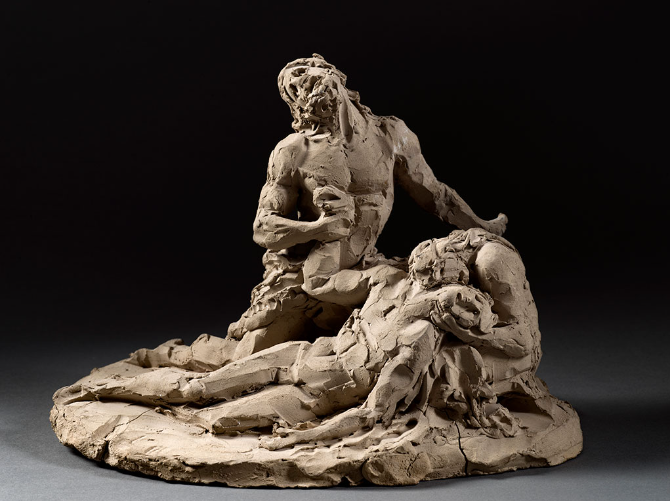Exhibitions to fill up a monotonous summer schedule
Antonio Canova’s piece, “Adam and Eve Mourning the Dead Abel,” is shown in its beginning terracotta stages. The National Gallery of Art will be displaying Canova’s sculpting process and practice pieces in the exhibition “Canova: Sketching in Clay” that will debut on June 11, 2023.
June 8, 2023
Temperatures rise and the air humidifies as summer climaxes. Days drag on and become repetitive as school creeps closer. Around the midway mark of the work-free season, students begin to feel boredom. For WCHS students who want a new pastime, these local art exhibitions opening in the upcoming months will be the perfect fix for a dull summer schedule.
“Canova: Sketching in Clay” (Starting June 23 at the National Gallery of Art)
Renowned neoclassical artist Antonio Canova is famous for his beautiful marble sculptures such as “Psyche Revived by Cupid’s Kiss” and “The Three Graces.” However, the process by which his pieces are formed is largely unknown. In just a few minutes, Canova used small tools to create intricate designs that were later refined and replicated into his well-known marble pieces. The upcoming National Gallery of Art exhibit will display the clay pieces that transformed Canova’s ideas into reality. The exhibition is for those who are fascinated by classical forms of art and want to dig deeper into what brought such pieces to life.
“Treasures and Troubles: Looking Inside a Legendary Blues Archives” (Starting June 23 at the National Museum of American History)
Blues music originated in the deep south as singers expressed their hardships rhythmically and melodically. Over time, it became vastly popular as people found they could relate to the tales of everyday struggles and sorrows expressed in the music. Richard McCormick was a blues enthusiast who compiled blues archives containing research on artists dating back to the 1950s. The collection contains manuscripts, notes, interviews, contracts, photographs and more. This unique opportunity would be perfect for music lovers who want to immerse themselves in the rich culture of the blues.
“Many Wests: Artists Shape an American Idea” (Starting July 28 at the Smithsonian American Art Museum)
History has often been told through the lens of the white American. Now, 48 contemporary artists will give viewers a broader and more accurate view of the past. This exhibition will highlight misconceptions concerning Euro-American historical accounts and spotlight current communities residing in the West. The exhibit will provide its audience with a multitude of views surrounding history by including Latin, Asian American, Black, Indigenous and LGBTQ+ artists. Many of the topics will feel familiar to students who have taken Art History, World History or United States History. This could be an intriguing dive into diverse perspectives on the content they previously learned in school.
“An American Photographer’s Journey, 1960s To Present” (Starting June 10 at The Phillips Collection)
Photographer Frank Stewart’s visual autobiography guides viewers through a 60-year journey through more than 100 photographs. Stewart spent his life on the road, constantly meeting new people and discovering exciting aspects of different cultures. His works offer the audience a gateway into his life and customs worldwide. Emotional images of intimate human experiences are portrayed throughout his collection with a wide range of locations and subjects. Characteristics of Black culture are captured in different forms such as art, travel, music and dance. Furthermore, Stewart’s experience as the senior staff photographer at Lincoln Center Orchestra allowed him to capture images of various performances of jazz legends such as Miles Davis, Ahmad Jamal and Wynton Marsalis. WCHS students who go to “An American Photographer’s Journey, 1960s to Present” can take a deeper look into a distinct collection of photographs from around the world.
“Reconstructing Weatherbreak in an Age of Extreme Weather” (Starting July 1 at the National Museum of American History)
In the 1950s, American architect Buckminster Fuller’s student, Jeffrey Lindsey, built the first geodesic dome in North America. This structure was able to withstand extreme weather conditions while also being energy efficient. Students from the Catholic University of Architecture and Planning partnered with the National Museum of American History to recreate the original dome, “Weatherbreak,” in the museum’s Flag Hall. The reconstruction proves relevant since society has found itself in an age of constantly worsening and evolving climate conditions. Those who want to see this building from the past revived should attend the month-long exhibition.
Summer can become monotonous after weeks of lacking commitments or work. In some cases, it is difficult to find what to do with the excess time a school-free schedule provides students with. Yet, with Washington D.C. a short drive away, exploring new exhibits could be just the cure for a summer slump!



